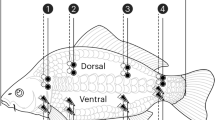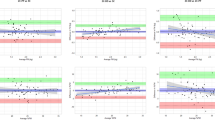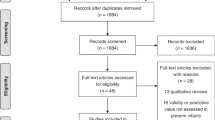Abstract
Background/Objectives:
To evaluate nutritional interventions in preterm infants, a simple, accurate assessment of the type of growth, that is, change in body composition through the relative contributions of lean body tissue and fat mass to weight gain, is needed. Bioelectrical impedance may provide such a method. The aim of this study was to develop resistivity coefficients appropriate for use in bioelectrical impedance spectroscopy (BIS) analysis of body water volumes in preterm infants.
Subjects/Methods:
A total of 99 preterm infants were enrolled (mean gestational age 32 completed weeks). Total body water (TBW) and extracellular water (ECW) were determined using the reference methods of deuterium and bromide dilution. BIS measurements taken at the same time allowed calculation of resistivity coefficients. Predictions of TBW and ECW obtained using these coefficients were then validated against volumes determined using the reference methods in a separate cohort of infants.
Results:
Data were available for 91 preterm infants. BIS-predicted TBW and ECW correlated well with the measured volumes (Pearson’s rp=0.825 and 0.75, respectively). There was a small bias (TBW 10 ml and ECW 40 ml) but large limits of agreement (TBW±650 ml and ECW ±360 ml).
Conclusions:
BIS appears to have limited clinical utility; however, the relatively small bias means that it may be useful for measurements within a population or for comparisons between groups in which population means rather than individual values are compared.
This is a preview of subscription content, access via your institution
Access options
Subscribe to this journal
Receive 12 print issues and online access
$259.00 per year
only $21.58 per issue
Buy this article
- Purchase on Springer Link
- Instant access to full article PDF
Prices may be subject to local taxes which are calculated during checkout




Similar content being viewed by others
References
Franz AR, Pohlandt F, Bode H, Mihatsch WA, Sander S, Kron M et al. Intrauterine, early neonatal, and postdischarge growth and neurodevelopmental outcome at 5.4 years in extremely preterm infants after intensive neonatal nutritional support. Pediatrics 2009; 123: e101–e109.
Ehrenkranz RA, Dusick AM, Vohr BR, Wright LL, Wrage LA, Poole WK et al. Growth in the neonatal intensive care unit influences neurodevelopmental and growth outcomes of extremely low birth weight infants. Pediatrics 2006; 117: 1253–1261.
Latal-Hajnal B, von Siebenthal K, Kovari H, Bucher HU, Largo RH . Postnatal growth in VLBW infants: significant association with neurodevelopmental outcome. (see comment). J Pediatr 2003; 143: 163–170.
Singhal A, Cole TJ, Fewtrell M, Deanfield J, Lucas A . Is slower early growth beneficial for long-term cardiovascular health? Circulation 2004; 109: 1108–1113.
Jackson AA, Burdge GC, Lillycrop KA . Diet. nutrition and modulation of genomic expression in fetal origins of adult disease. World Rev Nutr Diet 2010; 101: 56–72.
Kyle UG, Bosaeus I, De Lorenzo AD, Deurenberg P, Elia M, Manuel Gomez J et al. Bioelectrical impedance analysis-part II: utilization in clinical practice. Clin Nutr 2004; 23: 1430–1453.
Montagnese C, Williams JE, Haroun D, Siervo M, Fewtrell MS, Wells JC . Is a single bioelectrical impedance equation valid for children of wide ranges of age, pubertal status and nutritional status? Evidence from the 4-component model. Eur J Clin Nutr 2012; e-pub ahead of print 18 January 2012; doi:10.1038/ejcn.2011.213.
Kyle UG, Bosaeus I, De Lorenzo AD, Deurenberg P, Elia M, Gomez JM et al. Bioelectrical impedance analysis—part I: review of principles and methods. Clin Nutr 2004; 23: 1226–1243.
Baumgartner R . Electrical impedance and total body electrical conductivity. In: Roche AF, Heymsfield SB, Lohman TG (eds). Human Body Composition. Human Kinetics: Champaign, Ilinois, 1996, pp 79–107.
Nielsen BM, Dencker M, Ward L, Linden C, Thorsson O, Karlsson MK et al. Prediction of fat-free body mass from bioelectrical impedance among 9- to 11-year-old Swedish children. Diabetes Obes Metab 2007; 9: 521–539.
Matthie JR . Bioimpedance measurements of human body composition: critical analysis and outlook. Expert Rev Med Devices 2008; 5: 239–261.
Jaffrin MY, Morel H . Body fluid volumes measurements by impedance: a review of bioimpedance spectroscopy (BIS) and bioimpedance analysis (BIA) methods. Med Eng Phys 2008; 30: 1257–1269.
Buchholz AC, Bartok C, Schoeller DA . The validity of bioelectrical impedance models in clinical populations. Nutr Clin Pract 2004; 19: 433–446.
De Lorenzo A, Andreoli A, Matthie J, Withers P . Predicting body cell mass with bioimpedance by using theoretical methods: a technological review. J Appl Physiol 1997; 82: 1542–1558.
Jaffrin MY, Fenech M, Moreno MV, Kieffer R . Total body water measurement by a modification of the bioimpedance spectroscopy method. Med Biol Eng Comput 2006; 44: 873–882.
Lof M, Forsum E . Evaluation of bioimpedance spectroscopy for measurements of body water distribution in healthy women before, during, and after pregnancy. J Appl Physiol 2004; 96: 967–973.
Ellis KJ, Wong WW . Human hydrometry: comparison of multifrequency bioelectrical impedance with 2H2O and bromine dilution. J Appl Physiol 1998; 85: 1056–1062.
Ellis KJ, Shypailo RJ, Wong WW . Measurement of body water by multifrequency bioelectrical impedance spectroscopy in a multiethnic pediatric population. Am J Clin Nutr 1999; 70: 847–853.
Ward LC, Elia M, Cornish BH . Potential errors in the application of mixture theory to multifrequency bioelectrical impedance analysis. Physiological Measur 1998; 19: 53–60.
Schoeller DA . Hydrometry. In: Roche AF, Heymsfield SB, Lohman TG (eds). Human Body Composition. Human Kinetics: Champaign, Ilinois, 1996, pp 25–44.
Cornish BH, Ward LC, Thomas BJ, Jebb SA, Elia M . Evaluation of multiple frequency bioelectrical impedance and Cole–Cole analysis for the assessment of body water volumes in healthy humans. Eur J Clin Nutr 1996; 50: 159–164.
Lingwood BE, Coghlan JP, Ward LC, Charles BG, Colditz PB . Measurement of extracellular fluid volume in the neonate using multiple frequency bio-impedance analysis. Physiol Measur 2000; 21: 251–262.
Cornish BH, Thomas BJ, Ward LC . Improved prediction of extracellular and total body water using impedance loci generated by multiple frequency bioelectrical impedance analysis. Phys Med Biol 1993; 38: 337–346.
Sesmero M-A, Mazariegos M, Pedron C, Jones J, Solomons NW . Bioimpedance electrical spectroscopy in the first six months of life: some methodologic considerations. Nutrition 2005; 21: 567–573.
Mayfield SR, Uauy R, Waidelich D . Body composition of low-birth-weight infants determined by using bioelectrical resistance and reactance. Am J Clin Nutr 1991; 54: 296–303.
Miller ME, Cosgriff JM, Forbes GB . Bromide space determination using anion-exchange chromatography for measurement of bromide. Am J Clin Nutr 1989; 50: 168–171.
Jennings G, Bluck L, Wright A, Elia M . The use of infrared spectrophotometry for measuring body water spaces. Clin Chem 1999; 45: 1077–1081.
Hartnoll G, Betremieux P, Modi N . Body water content of extremely preterm infants at birth. Arch Dis Child Fetal Neonatal Ed 2000; 83: F56–F59.
Cornish BH, Ward LC . Data analysis in multiple-frequency bioelectrical impedance analysis. Physiol Measur 1998; 19: 275–283.
Sivan Y, Merlob P, Reisner SH . Sternum length, torso length, and internipple distance in newborn infants. Pediatrics 1983; 72: 523–525.
Sivan Y, Merlob P, Reisner SH . Upper limb standards in newborns. Am J Dis Child 1983; 137: 829–832.
Merlob P, Sivan Y, Reisner SH . Anthropometric measurements of the newborn infant (27 to 41 gestational weeks). Birth Defects Orig Artic Ser 1984; 20: 1–52.
Merlob P, Sivan Y, Reisner SH . Lower limb standards in newborns. Am J Dis Child 1984; 138: 140–142.
Merlob P, Sivan Y, Reisner SH . Ratio of crown-rump distance to total length in preterm and term infants. J Med Genet 1986; 23: 338–340.
Fomon SJ, Haschke F, Ziegler EE, Nelson SE . Body composition of reference children from birth to age 10 years. Am J Clin Nutr 1982; 35: 1169–1175.
Snee RD . Validation of regression models: methods and examples. Technometrics 1977; 19: 415–428.
Lin LI . A concordance correlation coefficient to evaluate reproducibility. Biometrics 1989; 45: 255–268.
Bland JM, Altman DG . Statistical methods for assessing agreement between two methods of clinical measurement. Lancet 1986; 1: 307–310.
Lingwood BE, Storm van Leeuwen AM, Carberry AE, Fitzgerald EC, Callaway LK, Colditz PB et al. Prediction of fat-free mass and percentage of body fat in neonates using bioelectrical impedance analysis and anthropometric measures: validation against the PEA POD. Br J Nutr 2012; 107: 1545–1552.
Geddes LA, Baker LE . The specific resistance of biological material--a compendium of data for the biomedical engineer and physiologist. Med Biol Eng 1967; 5: 271–293.
Gabriel C, Gabriel S, Corthout E . The dielectric properties of biological tissues: I. Literature survey. Phys Med Biol 1996; 41: 2231–2249.
Gabriel S, Lau RW, Gabriel C . The dielectric properties of biological tissues: II. Measurements in the frequency range 10 Hz to 20 GHz. Phys Med Biol 1996; 41: 2251–2269.
Rees A, Ward LC, Cornish BH, Thomas BJ . Sensitivity of multiple frequency bioelectrical impedance analysis to changes in ion status. Physiol Measur 1999; 20: 349–362.
Moon JR, Smith AE, Tobkin SE, Lockwood CM, Kendall KL, Graef JL et al. Total body water changes after an exercise intervention tracked using bioimpedance spectroscopy: a deuterium oxide comparison. Clin Nutr 2009; 28: 516–525.
Ward LC, Isenring E, Dyer J, Battersby K, Bengston J, Kagawa M . Constancy of resistivity coefficients for bioimpedance spectroscopy (BIS). Int J Body Comp Res 2008 6 (abstract 11-OR).
Moissl UM, Wabel P, Chamney PW, Bosaeus I, Levin NW, Bosy-Westphal A et al. Body fluid volume determination via body composition spectroscopy in health and disease. Physiol Meas 2006; 27: 921–933.
Cox-Reijven PL, Soeters PB . Validation of bio-impedance spectroscopy: effects of degree of obesity and ways of calculating volumes from measured resistance values. Int J Obes Relat Metab Dis 2000; 24: 271–280.
Dewit O, Ward LC, Middleton SJ, Watson C, Friend PJ, Elia M . Multi-frequency bioimpedance: a bed-side technique for assessment of fluid shift patterms in a patient with severe dehydration. Clin Nutr 1997; 16: 189–192.
Brace RA . Fluid distribution in the fetus and neonate. In: Polin RA, Fox WW (eds). Fetal and Neonatal Physiology. W.B. Saunders Co: Philadelphia, 1992, pp 1288–1298.
Ward LC . Segmental bioelectrical impedance analysis: an update. Curr Opin Clin Nutr 2012; 15: 424–429.
Acknowledgements
This study was supported by grants from the Women’s and Children’s Hospital Foundation, Adelaide, South Australia, the International Atomic Energy Association and the Department of Neonatal Medicine, Women’s and Children’s Hospital Consultant’s Fund. Publication of this article was supported by a grant from seca Gmbh & Co. KG, Hamburg, Germany.
Author information
Authors and Affiliations
Corresponding author
Ethics declarations
Competing interests
MM has received grant support from Mead Johnson Nutrition and the Australian Egg Corporation Limited (AECL). MM’s host institution received consultant fees from Fonterra and Nestle Nutrition Institute. RAG’s host institution received consultant fees from Fonterra. LCW has consulted to ImpediMed Ltd. ImpediMed Ltd. had no involvement in the conception and execution of this study, analysis, interpretation or in the preparation of the manuscript. The remaining authors declare no conflict of interest.
Rights and permissions
About this article
Cite this article
Collins, C., Reid, J., Makrides, M. et al. Prediction of body water compartments in preterm infants by bioelectrical impedance spectroscopy. Eur J Clin Nutr 67 (Suppl 1), S47–S53 (2013). https://doi.org/10.1038/ejcn.2012.164
Published:
Issue Date:
DOI: https://doi.org/10.1038/ejcn.2012.164
Keywords
This article is cited by
-
Prediction of fat-free mass in young children using bioelectrical impedance spectroscopy
European Journal of Clinical Nutrition (2023)
-
Body composition in preterm infants: a systematic review on measurement methods
Pediatric Research (2023)
-
Body composition measurement for the preterm neonate: using a clinical utility framework to translate research tools into clinical care
Journal of Perinatology (2022)
-
Using bioelectrical impedance analysis in children and adolescents: Pressing issues
European Journal of Clinical Nutrition (2022)
-
The influence of body position on bioelectrical impedance spectroscopy measurements in young children
Scientific Reports (2021)



